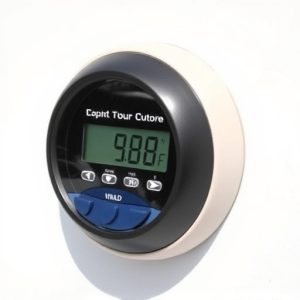Inground Pool Safety: Installing and Maintaining Swimming Pool Alarms
Swimming pool alarms for inground pools are essential safety devices that help prevent unauthorized …….
Swimming pool alarms for inground pools are essential safety devices that help prevent unauthorized access and drowning by detecting motion or disturbances in the water. These alarms come in wired and wireless models, with advanced technology to minimize false alarms and differentiate between safe and unsafe scenarios. Pool owners must choose a system that fits their specific needs, integrates with local safety standards, and is compatible with their pool's dimensions and usage patterns. Regular maintenance, including checking battery backups and sensor cleaning, is crucial for ensuring the alarm functions correctly in emergencies. It's also vital to test the system weekly and after any maintenance or battery replacement to maintain its effectiveness as a drowning prevention tool. Adhering to manufacturer instructions and local regulations will guarantee that your inground pool alarm provides continuous safety assurance.
When integrating pool safety into your backyard oasis, inground swimming pool alarms are a pivotal safeguard. This article delves into the essential aspects of selecting, installing, and maintaining an alarm system tailored for inground pools. We’ll explore the critical role these alarms play in ensuring the well-being of your loved ones and unauthorized access prevention. From understanding their purpose to mastering their upkeep, discover how these devices can provide peace of mind without compromising the serenity of your poolside retreat.
Understanding Pool Alarms: The Importance of Safety for Inground Pools
Swimming pool alarms are critical safety devices for inground pool owners, serving as a deterrent against unauthorized access and drowning incidents. These alarms are specifically designed to detect motion or changes in the water surface, triggering an audible alarm to alert homeowners of potential intrusions or accidents involving children, pets, or even adult swimmers who may be alone. Installing swimming pool alarms for inground pools is not just a precautionary measure; it’s an essential component of a comprehensive safety strategy. The sensitivity and specificity of these alarms are tailored to discern between safe and hazardous situations, ensuring that false alarms do not diminish their effectiveness or reliability. Homeowners can choose from wired or wireless options, with the latter providing greater flexibility in installation and the ability to cover larger areas without the constraints of proximity to a power source. By incorporating swimming pool alarms as part of the inground pool safety protocol, individuals can significantly reduce the risks associated with unsupervised water exposure, fostering a safer environment for both recreational and learning purposes. It’s crucial for pool owners to select a model that aligns with their specific needs and adheres to local safety regulations, ensuring the highest level of protection for all users. Regular maintenance and testing of these alarms are also imperative to guarantee continuous functionality and readiness in the event of an emergency.
Types of Pool Alarms Suitable for Inground Swimming Pools
When securing an inground swimming pool, it’s crucial to invest in reliable pool alarms designed specifically for this setting. These alarms serve as a vital layer of safety, providing real-time notifications if an unauthorized individual—or a child—enters the pool area. There are several types of pool alarms suitable for inground swimming pools, each with its unique features and applications. Surface motion detectors are one such option; they’re installed on the surface of the water and trigger an alarm when any movement is detected. Another popular choice is the wave-interruption type, where sensors placed within the pool walls detect disturbances in the water’s surface, signaling an alert if an interruption occurs beyond normal activity like swimming laps. For a more comprehensive approach, acoustic presence detectors can be used; these devices monitor for sounds that indicate someone has entered or is moving around the pool area.
In addition to these, safety-conscious homeowners might consider automatic pool covers, which not only act as alarms but also provide a physical barrier to prevent unauthorized access. These covers can be equipped with sensors that will sound an alarm if lifted or tampered with. It’s also worth exploring smart pool alarms that integrate with home automation systems, allowing for remote monitoring and instant notifications to the homeowner’s mobile device. When selecting the most appropriate pool alarm for an inground swimming pool, consider factors such as ease of installation, compatibility with your existing pool system, and the level of security required based on the pool’s usage and accessibility. Opting for the right pool alarm can provide peace of mind, knowing that your loved ones are safer from accidental or unauthorized access to the pool.
Installation and Configuration: Ensuring Your Inground Pool Alarm Works Optimally
When securing your inground pool, it’s imperative to have a reliable alarm system in place to ensure safety and peace of mind. Installing swimming pool alarms for inground pools is a multi-step process that begins with careful selection based on your specific pool dimensions and the type of detection technology you prefer, whether it be surface motion, wave or acoustic sensors, or underwater pressure sensors. Once the appropriate alarm model is chosen, the installation should be carried out according to the manufacturer’s guidelines. This typically involves placing the sensor unit(s) in strategic locations within the pool to monitor for unauthorized access. The control box, which processes signals from the sensors and triggers the audible or visual alarms, should be installed in a secure and easily accessible location near the pool area but not too close to potentially interfere with the sensors’ functionality.
After installation, configuration is key to optimize the performance of your inground pool alarm system. You’ll need to set sensitivity levels for the detection devices to minimize false alarms while still providing effective monitoring. Calibration may be necessary to ensure accurate readings and to avoid nuisance alarms from regular pool activities like diving or playing. Additionally, regular testing and maintenance are essential to maintain optimal functionality. Battery backups should be checked regularly to prevent the system from failing in a power outage. User manuals often provide detailed instructions for both installation and configuration; however, professional assistance can ensure that your swimming pool alarms for inground pools are functioning correctly from day one. Always adhere to local regulations and safety standards when installing and configuring your pool alarm system to meet the necessary requirements for legal compliance and enhanced protection.
Maintenance and Testing: Keeping Your Inground Pool Alarm Reliable and Effective
When it comes to ensuring the safety and security of an inground pool, investing in a reliable swimming pool alarm is just the beginning. To maintain the effectiveness of these alarms, regular maintenance and consistent testing are crucial. It’s imperative to follow the manufacturer’s guidelines for maintaining your specific model of inground pool alarm. This typically involves checking the battery levels regularly, cleaning any sensors or wires that could be compromised by environmental factors, and ensuring there are no obstructions affecting the alarm’s functionality.
Testing your swimming pool alarms for inground pools should be a routine procedure, ideally performed weekly. Activate the alarm to confirm it responds accurately to changes in water level or temperature. Perform these tests when swimmers are not present to avoid false alarms. Additionally, after any maintenance or battery replacement, conduct a thorough test to verify that the alarm is functioning as intended. Regular upkeep and systematic testing can prevent malfunctions and ensure your inground pool alarm serves as an effective safeguard against potential drowning incidents.


